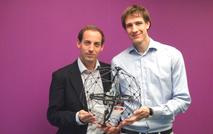Flyability announces completion of a seed round of financing
04.02.2015
The EPFL spin-off Flyability SA develops robust flying robots. On February 2nd, 2015, the start-up announced the completion of its first external round of equity capital from European and Swiss business angels.
 Flyability is focused on developing the world's first collision-tolerant robot.
|
Founded last year, Flyability is focused on developing the world's first collision-tolerant robot, Gimball, which is also safe to fly close to humans. In 2014, its CEO Patrick Thevoz was part of the venture leaders USA adventure and flew to Boston and New York for a 10 days commercial development program. Here is his reaction after his US trip: "New York is huge! At least 5 to 10 times larger than Ecublens!" Flyability is also a venture kick Alumnus. On February 2nd, 2015, the economy magazine Bilan selected the young company in its list of 50 Swiss startups in which to invest.
The world's first collision-tolerant robot - Swiss made.
The company's patented technology allows drones to enter places unreachable with other robots and offering a cheaper, faster and safer alternative to sending humans in dangerous locations. First targeting the inspection of energy and transportation infrastructures, the company's technology opens a world of new applications and interaction with flying robots in the fields of entertainment, security, domotics and search and rescue.
Equipped with a HD camera, Flyability’s first product, Gimball, is protected by an external spherical frame decoupled from the avionics which allows the robot to fly in contact with objects, to roll on any surface, and to remain stable after a collision. In addition to improving the safety of the operation, these unique features allow the robot to gather close-up images to detect even the smallest defects, and requires almost no prior training or experience in piloting as mistakes that previously meant crashing a drone now only result in the robot bouncing against obstacles. Moreover, the cage means that it is safe for humans to touch it during the flight. It is bringing the vision of service drones operating among populated areas one step closer to reality, for instance for goods delivery.
Dr. Adrien Briod, CTO and co-founder of the company comments that "the funds will be used to finalize the development and manufacturing of our beta prototypes, to allow the delivery to our first customers as early as April 2015". CEO Patrick Thévoz adds that a second round of financing will be opened during the year to prepare the launch of the commercial product.
Listen to the BBC interview of Patrick Thévoz (04.02.2015).
Watch the EPFL video about Flyability (2013):
The world's first collision-tolerant robot - Swiss made.
The company's patented technology allows drones to enter places unreachable with other robots and offering a cheaper, faster and safer alternative to sending humans in dangerous locations. First targeting the inspection of energy and transportation infrastructures, the company's technology opens a world of new applications and interaction with flying robots in the fields of entertainment, security, domotics and search and rescue.
Equipped with a HD camera, Flyability’s first product, Gimball, is protected by an external spherical frame decoupled from the avionics which allows the robot to fly in contact with objects, to roll on any surface, and to remain stable after a collision. In addition to improving the safety of the operation, these unique features allow the robot to gather close-up images to detect even the smallest defects, and requires almost no prior training or experience in piloting as mistakes that previously meant crashing a drone now only result in the robot bouncing against obstacles. Moreover, the cage means that it is safe for humans to touch it during the flight. It is bringing the vision of service drones operating among populated areas one step closer to reality, for instance for goods delivery.
Dr. Adrien Briod, CTO and co-founder of the company comments that "the funds will be used to finalize the development and manufacturing of our beta prototypes, to allow the delivery to our first customers as early as April 2015". CEO Patrick Thévoz adds that a second round of financing will be opened during the year to prepare the launch of the commercial product.
Listen to the BBC interview of Patrick Thévoz (04.02.2015).
Watch the EPFL video about Flyability (2013):


